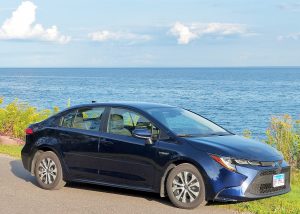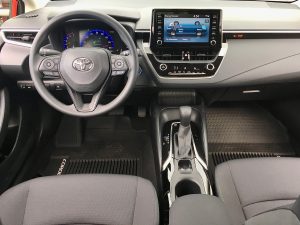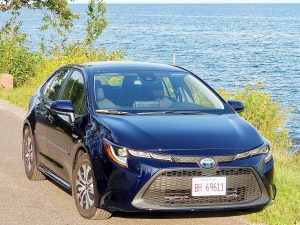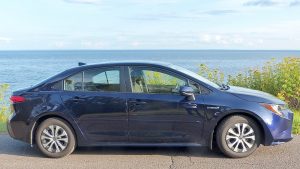New Corolla Adds Hybrid, Global Platform

Toyota Corolla may have become “green” with Hybrid model, but the blue of 2020 Corolla Hybrid blends with Lake Superior blue.
By John Gilbert
We get hardened to criticism of certain cars by the public, or media, until it almost becomes traditional. Toyota, which sells enormous quantities of all manner of cars and trucks all around the world, might be the biggest victim, because critics became cynics in declaring cars like the Camry and Corolla as dull, boring “appliances,” rather than fun and enjoyable cars.
I understand the criticism, and even engaged in some of it, because once it had reached a certain point of consistency, Toyota seemed more interested in maintaining the status quo than striving for a higher plateau. More recently, I didn’t anticipate that the Prius, Toyota’s standard-bearer of hybrid vehicles, had come under similar criticism, because while I never thought of the Prius as boring, I also gave it room because it was always pushing the barriers of gasoline-electric powertrains. I learned of the cynicism while driving a beautiful dark blue 3030 Toyota Corolla, and we parked at an available parking space in West Duluth. We locked the Corolla with the key fob, and saw a fellow we know, and who knew I evaluated new cars. He nodded toward the Corolla and said, “If that your new test drive?”
I said yes, it was, and added that it was a 2020 Corolla, which is, shall we say, cautiously restyled, and that this particular one was a Hybrid.
“A Hybrid?” he responded, with obvious surprise.
I explained that for 2020 Toyota’s revamped Corolla compact line has a new global platform and a new body with stylish contours carved in. Corollas always have tried to look stylish-on-a-budget, but they haven’t been hybrids. And they haven’t been adorned with this impressive new “Blueprint” exterior paint.
“This one,” I said, “has the same drivetrain as the Prius I had reported on a month or so earlier.”
“Well then,” he shot back, “why would anyone buy a Prius?:”
Apparently, the masses might consider the Prius commonplace, even dull and uninteresting. Particularly if they haven’t driven a new one recently, such as the quick and impressive all-wheel-drive Prius from my recent Newcarpicks.com review. I have driven the various Prius models all the way through their existence, and I can appreciate the evolutionary changes to more efficient methods of linking the electric motors to the gasoline engine, which recharges the electric motors as they drive the car.
My acquaintance wouldn’t let up. “If it’s the same drivetrain, then why would you buy the Prius?” he asked. “The Corolla is much more car.”
There you have it. The masses may not be influenced by the latest improvements in technology, but they know what they like. I like the new Prius, particularly the all-wheel-drive model with its new edgy shape and 50-plus miles per gallon.
However, I also had to go back to my notes for comparison sake. The Prius, fixed with its instruments on the center of the dashboard, and its hatchback design, cost a base price of $28,810, and the AWD model I drove was $32,508. Well, I figured, technology costs money, ao that’s not so bad.
Then I looked at the Corolla Hybrid I had in my possession for that late-August week. It had a base price, in LE (middle) trim, of $22,950, and with only a couple of molding and floor mat options, the Hybrid LE sticker read $24,467.
Both the Corolla Hybrid and the Prius were powered by Toyota’s 1.8-liter, 4-cylinder, dual-overhead-cam, engine, with variable valve timing, coupled with the Toyota Synergy Drive nickel-metal-hydride battery pack and electric motors. Both the front-wheel-drive Corolla and the all-wheel-drive Prius, run their 121 combined horsepower and continuously variable transmissions with programmed stepped shift-points that can be manually driven to resemble a 9-speed automatic, if you choose.
The Corolla is not a hatchback. It has a trunk. American buyers have recently indicated that we don’t like hatchbacks, even though I find them often more flexible and useful than cars with trunks. But maybe that’s the secret behind putting the hybrid drivetrain out of the Prius into the Corolla. If you like a hatchback, buy the Prius; if you’d rather have a trunk, buy the Corolla Hybrid.
But I have just enough Scottish ancestry to add another part fo the equation: If you’d rather have $8,000 than commit it to your new car price, buy the Corolla!
The new Corolla looks a little more like a sporty compact than like an appliance. The Camry and the Corolla have looked good for about a decade, but they do have something of a soap-carving-project look to them, when compared to cars like the Mazda3 and the Honda Civic — Corolla’s top two rivals — and emerging challengers like Hyundai Elantra and Nissan Sentra.
The new Corolla shakes that image somewhat, but still seems bound by stylists who are more worried about losing existing owners than making a move to become more stylish.
Inside, the driving position is improved, with better seats, more contemporary instruments and gauges, changeable at the touch of a button, or two, on the Swiss-Army-belt-like steering wheel.
The exterior has stylish 15-inch alloy wheels with all-season tires, and they support a whole range of contemporary safety and driver-aid features that hoist the Corolla up among the more accomplished models.
Start with a black mesh grille in front, a high-handed move for the usually conservative company, and the new grille spreads out to house LED headlights and daytime running lights, while at the rear, LED lights also brighten the tail and brake lights.
More significantly, the Toyota Safety Sense includes pre-collision aid with pedestrian warning, radar cruise control with full-range speed function, lane departure alert and assist, lane-tracing assist, automatic high beams with road-sign remote, stability control, traction control, electronic brake-force assist, and emergency stop assist.
That accumulation of safety features is impressive enough even if you take them separately, and they are considerably more impressive when all combined into the Corolla package. New for 2019 is the inclusion of Apple CarPlay and a large touch-screen with assorted USB connectivity is all there.
The instrument panel is configurable, so if you don’t see the need for a tachometer in the left binnacle from the speedometer, you can change it over to trip statistics or other car function readouts. Same with the right side. The center touch-screen is particularly useful because you can change that with a touch of a button, or the screen itself, to get things such as the power flow from the gas engine, the electric motor or the combination of both.
We also should avoid talking too much about the fold-down rear seats, because if you fold them down, elongating the trunk’s roomy storage area, you’re getting dangerously close to what hatchback-lovers like and hatchback-haters hate. I will add that at one point, we needed to take our gas can to pick up a couple gallons of lawn-mower fuel, and putting it in a trunk instead of under a hatch precluded any gasoline fumes from taking over the cabin.
We do still have the gauge package, which is directly through the steering wheel and in front of the driver, which I prefer to the Prius and its central location, atop the dashboard. That might be part of the feeling in the Prius that you’re helping carry out a long-term experiment. In that regard, the Corolla being “just a car” might be an asset.
When it’s time to refuel, the similarities with the Prius override the differences. The Corolla, which looks like a nice, contemporary compact, can get 50 miles per gallon, off an EPA estimated high of 53 miles per gallon in city driving and 52 on the highway. We got a pretty consistent mid-40s around town, with a couple spikes to 50, and it didn’t change much when we went on a highway trip.
You’d have to be living in a cave up in the mountains to be unaware that we’re heading rather swiftly toward a society driving electric cars, and we’re probably going to get to that point just about the time full-electric vehicles are ready to meet us with high-mileage batteries. In the meantime, you can shop around for some early-adopter electric vehicles, or choose a highly efficient gas-engine cars, or you can compromise from an ever-expanding list of hybrid cars — which now include the Corolla.
Some other hybrids compete well, and even favorably, with Toyota hybrids, but we also must acknowledge that Toyota has led the way with almost every step of hybrid growth. The Corolla Hybrid uses nickel-metal-hydride in its battery pack, while many competitors have gone to lithium-ion battery packs, claiming they charge faster, hold a charge longer, and deliver more power than the nickel-metal-hydride.
Toyota has some models that use lithium-ion, but when asked which is better, their engineers simply shrug, and put out the next generation of Priuses, and now Corollas. It’s still something of a secret that the Corolla has a Hybrid model, but for $24,000, it won’t be a secret for long.






 John Gilbert is a lifetime Minnesotan and career journalist, specializing in cars and sports during and since spending 30 years at the Minneapolis Tribune, now the Star Tribune. More recently, he has continued translating the high-tech world of autos and sharing his passionate insights as a freelance writer/photographer/broadcaster. A member of the prestigious North American Car and Truck of the Year jury since 1993. John can be heard Monday-Friday from 9-11am on 610 KDAL(www.kdal610.com) on the "John Gilbert Show," and writes a column in the Duluth Reader.
John Gilbert is a lifetime Minnesotan and career journalist, specializing in cars and sports during and since spending 30 years at the Minneapolis Tribune, now the Star Tribune. More recently, he has continued translating the high-tech world of autos and sharing his passionate insights as a freelance writer/photographer/broadcaster. A member of the prestigious North American Car and Truck of the Year jury since 1993. John can be heard Monday-Friday from 9-11am on 610 KDAL(www.kdal610.com) on the "John Gilbert Show," and writes a column in the Duluth Reader.